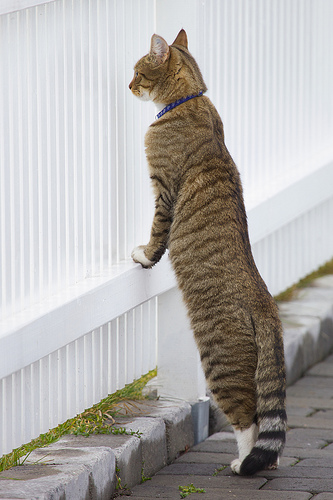Cat Fence Systems
A cat fence is a simple containment system that will keep your feline Houdini from escaping your yard. They can be electric or non-electric, may have mechanical components, or may be as simple as some secure netting.
As we all know, house cats are agile, strong, and great climbers. They're also crafty, and thanks to a unique bone structure can fit their bodies through almost any opening that they can fit their heads through.
This makes them excellent escape artists, and makes it important to make sure you make your fence or containment system cat proof.
There are a number of different ways to confine your cat, while allowing her to experience the outdoors. Probably the most secure of these systems is the six-sided rigid containment system (also known as a cage). Most typical outdoor cat enclosures are essentially large cages.
Cat fences, on the other hand, are a bit different. They can work as containment systems in one or more of several ways.
They can provide a barrier that your cat can't climb or find a way through. This is how netting systems work.
A very high, smooth wall that your cat has no way of jumping over or climbing would work for this as well.
Another way to contain your cat is to provide an unstable surface that your cat won't climb on.
Cats don't like unstable climbing surfaces, and often will avoid anything they don't perceive as stable.
This is how some cat fence products work, including Purrfect Fence (www.purrfectfence.com) and Affordable Cat Fence (www.catfence.com). Cat Fence-In (www.catfencein.com) works in a similar fashion. These work as sort of a passive cat repellent device.
Shocking Thoughts
An additional way to discourage escape is to make it unpleasant for your cat to enter an area or cross a barrier. This is how an electric fence with a radio collar works.
These are also referred to as invisible fences. PetSafe makes a popular device that can be set for tone only. Once your cat is trained to associate the tone with a shock, the tone alone can do its job.
I don't like the electric fence idea in that it trains via fear and unpleasantness. It's only mentioned here because its absence would seem odd.
It also seems to me that the wireless receiver in the collar is just too bulky to be comfortable for some cats. Also, if the collar breaks off, the system is rendered useless, at least until the cat is fully trained to stay within the area.
Safety First

http://www.flickr.com/photos/iboy/ / CC BY-SA 2.0
Keep in mind that cat fences are designed to keep your cat in, and don't necessarily work well to keep predators or other animals out of your yard.
This may endanger your cat. This is true for any outdoor enclosure system that doesn't fully protect your cat from intruders.
After all, your cat's safety comes first (that's the whole point of enclosures and confinement systems in the first place). From a safety perspective, it doesn't do much good to keep your cat contained in your yard if a person or other animal can enter the yard and injure her.
To reduce this danger, always give your cat a way to get to safety, and a way to get back inside the house. The Humane Society of the United States goes beyond that, and recommends you supervise your cat's outdoor excursions.
In addition, HSUS also recommends that if you're going to provide access to the outdoors, including an enclosure, that you also cat proof your yard.
Cat Lover Products
Cat Lovers Only




Comments: What do you think?
Have your say about what you just read. Leave me a comment in the box below.